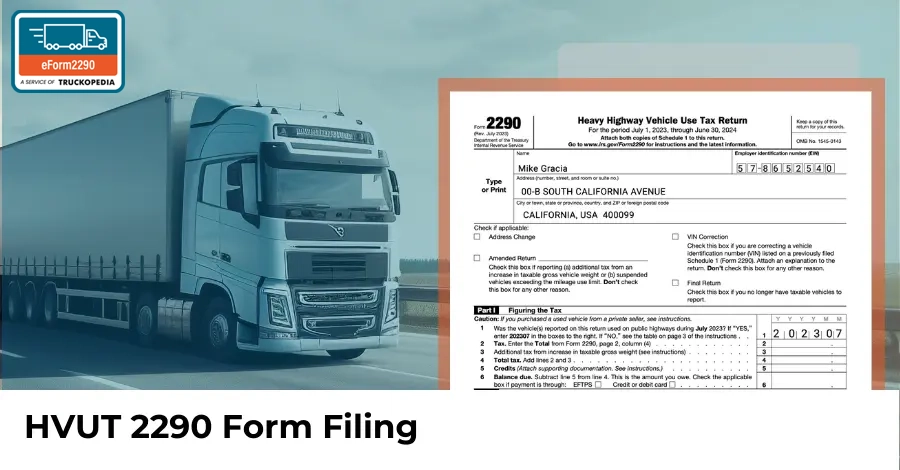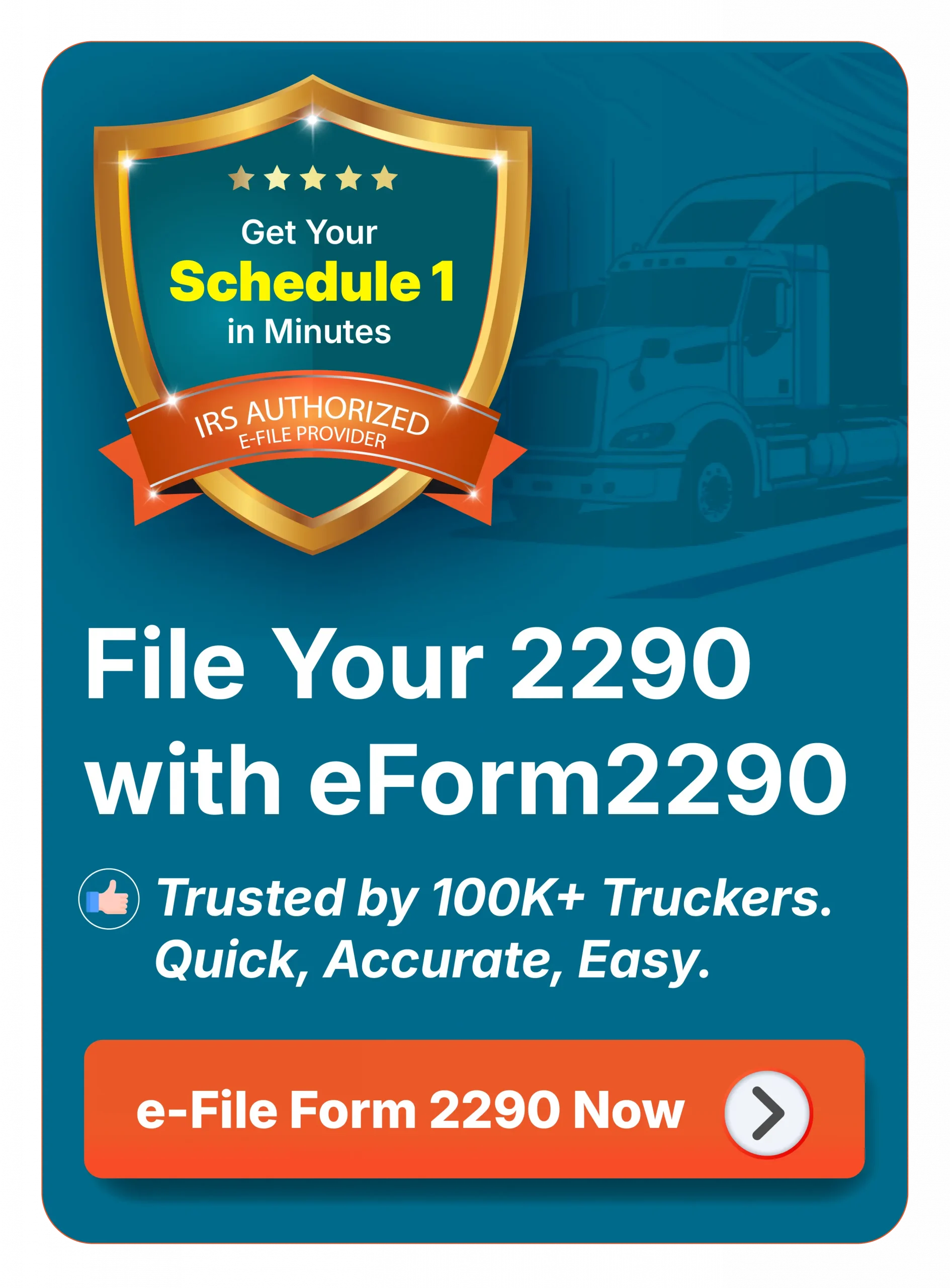Heavy Highway Use Tax (HVUT): Everything Truckers Need to Know

The Highway Use Tax, officially called the Highway Vehicle Use Tax (HVUT), is a mandatory federal tax that applies to heavy commercial vehicles operating on public highways. If your vehicle has a taxable gross weight of 55,000 pounds or more, you’re required to file HVUT Form 2290 each year to stay compliant. This federal highway use tax helps fund the maintenance, construction, and repair of U.S. highways; ensuring roads can withstand the wear and tear of large commercial vehicles. The more you use public infrastructure, the more critical it becomes to pay your share through the HVUT 2290 filing process.
Whether you're an owner-operator or a fleet manager, understanding how the Heavy Highway Use Tax works is key to avoiding penalties and staying IRS compliant.

When is Heavy Highway Use Tax Due?
The Heavy Highway Use Tax (HVUT) is a federal excise tax that must be filed annually using IRS Form 2290. It applies to heavy motor vehicles such as trucks, truck tractors, and buses that operate on public highways and have a taxable gross weight of 55,000 pounds or more.
This HVUT 2290 requirement helps fund the maintenance and repair of U.S. highways, ensuring that commercial vehicle operators contribute to the infrastructure they use regularly.
If your vehicle meets any of the following conditions, you’re likely required to file the 2290 highway use tax form:
- Commercial trucks used for freight or cargo hauling
- Truck tractors used in logistics or long-haul operations
- Buses used for transporting passengers
- Vehicles used in industrial or construction work
- Vehicles with a gross taxable weight of 55,000 pounds or more
Filing the heavy vehicle use tax form keeps you compliant with federal regulations and avoids IRS penalties.
Why does HVUT matter for highway funding?
The Heavy Vehicle Use Tax (HVUT) plays a key role in funding the Highway Trust Fund, which supports the construction, maintenance, and repair of public roads and bridges across the U.S.
When you file and pay the 2290 highway use tax, you're helping ensure that highways remain safe, reliable, and strong enough to support the demands of commercial transportation.
The HVUT helps make sure that the infrastructure supporting America’s freight economy continues to serve everyone—drivers, businesses, and communities alike.
How does HVUT support highway maintenance?
The Heavy Vehicle Use Tax (HVUT) provides essential funding to the Highway Trust Fund, which supports critical road and bridge projects across the U.S.
Revenue from HVUT Form 2290 helps maintain and improve the nation’s highway system through:
- Road and bridge repairs – Keep highways strong, safe, and reliable for heavy vehicles and everyday drivers
- New infrastructure construction – Support expansion to meet growing freight and transportation needs
- Traffic safety improvements – Help fund initiatives that ease congestion and enhance overall highway safety
Through the federal highway use tax, heavy vehicle operators contribute to the ongoing health of the infrastructure they rely on, without additional tolls or state-specific fees.

HVUT tax period and payment rules
The Heavy Vehicle Use Tax (HVUT) follows a tax year from July 1 to June 30 of the following year, in line with the IRS Form 2290 highway use tax schedule.
- Filing deadline: You must file Form 2290 by August 31 if your vehicle is in service at the start of the tax period. For vehicles with a different first use month, Form 2290 is due on the last day of the following month.
Check your Form 2290 due date based on your FUM
- 2290 tax amount: The HVUT amount is based on your vehicle’s taxable gross weight and annual mileage. The maximum annual tax is $550 per vehicle, but vehicles with limited use or those classified as suspended may qualify for reduced rates or exemptions.
Calculate your 2290 tax amount instantly!
HVUT filing and payment rules
To stay compliant with Heavy Vehicle Use Tax (HVUT) regulations, vehicle owners need to follow these steps:
1. File IRS Form 2290:
- File Form 2290 to report and pay the HVUT every year by August 31 for vehicles that are in use during the tax year (July 1–June 30). For vehicles placed in service later, the HVUT 2290 due date is the last day of the month following the vehicle's first use month (FUM).
2. Pay the correct tax amount:
- For vehicles weighing 55,000–75,000 pounds, the tax ranges from $100 to $550.
- For vehicles over 75,000 pounds, the annual tax is capped at $550 per vehicle.
Calculate your 2290 tax instantly! Enter your vehicle details and get an accurate HVUT estimate sent straight to your email—quick, easy, and stress-free!
3. Get your IRS-stamped Schedule 1:
This document is proof of HVUT payment and is required for:
- Registering or renewing your vehicle with the DMV.
- Meeting state and federal compliance checks.
By filing on time and paying the correct amount, truckers and fleet owners not only avoid penalties but also help maintain safer highways for everyone on the road.
Paying the Heavy Highway Use Tax online
If you operate a vehicle with a gross weight of 55,000 pounds or more, you're required to file Form 2290 and pay the Heavy Vehicle Use Tax (HVUT) each year. The easiest and fastest way to do this is through IRS-authorized e-filing providers like eForm2290.
By filing online, you can skip the paperwork, get your return processed quickly, and receive your IRS-stamped Schedule 1 instantly—a must-have for vehicle registration and compliance checks.
How to pay HVUT online?
Paying your HVUT 2290 online is the fastest and most efficient way to stay compliant with IRS regulations and receive your Schedule 1. Here's how to complete the process step by step:
1. Pick an IRS-Authorized e-File provider
To file Form 2290 online, you need to use the IRS e-file system or an IRS-approved e-file provider like eForm2290. These platforms simplify the process, guide you through each step and ensure faster IRS approval.
2. Fill out IRS Form 2290
Once you log in, complete the required details on Form 2290, including:
- Business Information: Your Employer Identification Number (EIN), business name, and contact details.
- Vehicle Information: The Vehicle Identification Number (VIN) and taxable gross weight of your truck.
- First Used Month (FUM): The month your vehicle first operated on public highways during the tax period.
- Suspended Vehicles: If your truck runs less than 5,000 miles a year (or 7,500 miles for agricultural vehicles), you can file for a suspension instead of paying tax. That means no tax is due but filing is still mandatory.
3. Calculate your HVUT Tax Amount
The heavy highway use tax depends on your vehicle’s gross weight and mileage category:
- Over 55,000 lbs: You must pay HVUT.
- Suspended Vehicles: No tax due, but filing is still required.
- Maximum Tax: $550 per vehicle per year.
Use the HVUT Tax Calculator to determine your exact amount.
4. Choose your HVUT payment method
The IRS offers multiple online payment options for HVUT:
1. Electronic Funds Withdrawal (EFW):
- Debits directly from your checking or savings account.
- Requires your bank routing and account numbers.
- Confirms payment instantly.
2. Electronic Federal Tax Payment System (EFTPS):
- An IRS-approved system that requires prior registration at eftps.gov.
- Payments typically take 1–2 business days to process.
3. Credit or Debit Card:
- Pay through IRS-approved third-party processors.
- A small processing fee applies.
- Ideal for quick, same-day payment confirmations.
4. Check or Money Order (Mail):
- Requires printing a payment voucher and mailing it to the IRS.
- Slower option—confirmation can take weeks and is not recommended for urgent filings.

Tips for a smooth HVUT payment process
To prevent delays or 2290 rejections by IRS, truckers should follow these key steps:
- Check your EIN: Make sure your Employer Identification Number (EIN) matches IRS records. A mismatch can cause your Form 2290 to be rejected.
- Double-check your VIN: Enter the correct Vehicle Identification Number (VIN). Use a VIN checker tool to avoid errors.
- Set up EFTPS early: If you plan to pay through the Electronic Federal Tax Payment System (EFTPS), create your account well before the deadline to avoid last-minute issues.
- Save your IRS-Stamped Schedule 1: Always keep a copy of Form 2290 Schedule 1—it’s required for vehicle registration renewal and DOT compliance checks.
Why should you pay HVUT online?
The IRS strongly recommends that truckers and fleet owners e-file Form 2290 instead of sending paper forms by mail. Online filing offers several key benefits:
- Faster processing: Get your IRS-stamped Schedule 1 in just minutes—no more waiting weeks for mail delivery.
- Safe and secure: Encrypted online payment systems keep your transactions fully protected.
- Instant updates: Receive email confirmations and digital copies of your payment and filing status right away.
- Easy record-keeping: Access all past filings and payment details online, with everything stored electronically.
- 24/7 convenience: File and pay your HVUT anytime, anywhere—no need to visit an office.
Who is exempt from paying HVUT?
Not all vehicles are required to pay the Heavy Vehicle Use Tax (HVUT), but many still need to file Form 2290 for documentation purposes.
1. Suspended Vehicles (Low Mileage Exemption)
- Vehicles that travel less than 5,000 miles per year (or 7,500 miles for agricultural vehicles) qualify for 2290 suspension.
- You must file Form 2290 to report the suspension status.
- No tax payment is required, but you must keep records in case the IRS requests proof.
2. Government and Non-Profit Vehicles
- Vehicles owned by federal, state, or local government agencies.
- Vehicles owned by the American Red Cross.
- Vehicles owned by volunteer fire departments or rescue squads.
3. Special Vehicle Categories
- Logging Trucks: Pay a reduced HVUT rate since they primarily operate off-highway in forest areas.
- Certain Agricultural Vehicles: Benefit from higher mileage limits before HVUT applies.
Even if your vehicle doesn’t owe HVUT, Form 2290 is still required for IRS records and DMV registration.

Penalties for missing HVUT payments
If you fail to file Form 2290 or pay the Heavy Vehicle Use Tax (HVUT) on time, the IRS will impose penalties and additional fees, which can add up quickly:
- Late Filing Penalty: 4.5% of the unpaid tax for every month you’re late, up to 5 months.
- Late Payment Penalty: 0.5% of the tax due, plus interest on the outstanding balance.
- Registration Hold: The DMV won’t allow registration and renewal of your vehicle without proof of payment (IRS-stamped Schedule 1).
To avoid these costly penalties, always file Form 2290 and pay your HVUT by the August 31 deadline.
File your HVUT the fast, easy, and secure way with eForm2290
Don’t wait until the deadline—e-file Form 2290 today with eForm2290 and receive your IRS-stamped Schedule 1 in just minutes! Our IRS-authorized platform provides instant error checks, free VIN corrections, and a 100% acceptance guarantee. With simple online filing, bulk submission options, and friendly bilingual U.S.-based support, staying compliant with HVUT has never been easier.
Get it done now—file your HVUT with eForm2290 and stay road-ready!



